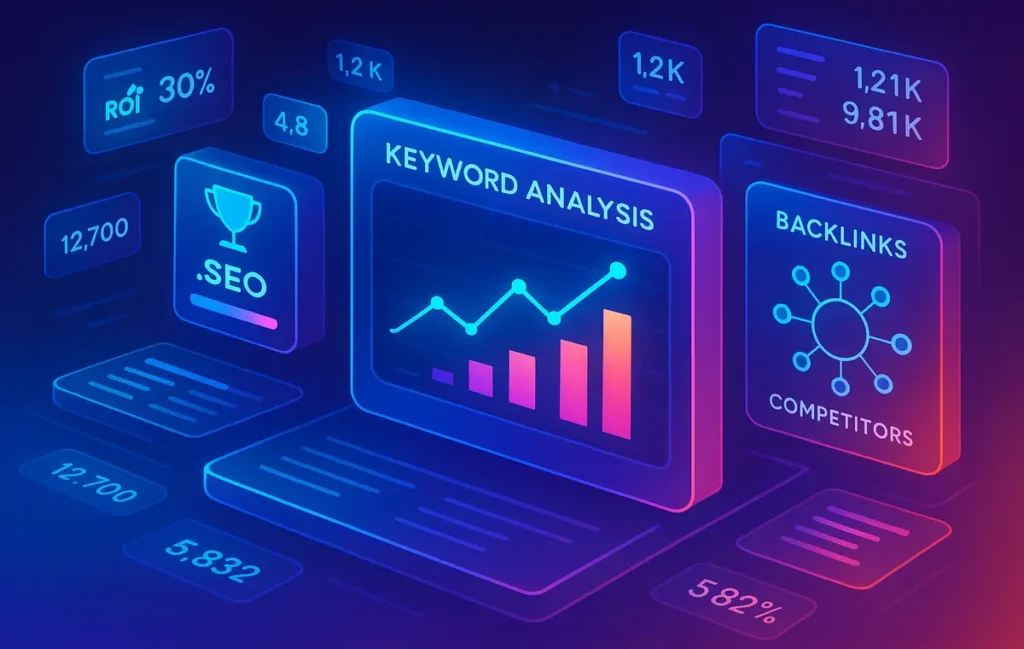🎯 Intro:
Every marketer eventually faces the same dilemma: is investing in Semrush really worth it? With hundreds of SEO and marketing tools available, Semrush has carved out a reputation as one of the most powerful and comprehensive platforms in the space. But reputation alone doesn’t guarantee ROI. For freelancers balancing tight budgets, SMBs chasing visibility, or agencies managing dozens of client accounts, the question remains: does Semrush deliver more value than it costs?
In this review, we’ll dive deep into Semrush’s data, features, limits, and real-world performance to help you decide if it belongs in your marketing stack.
🔎 What is Semrush?
Semrush is an all-in-one digital marketing suite that combines SEO, content marketing, paid ads, and competitive intelligence in one platform. Founded in 2008, it has grown into a go-to tool for marketers worldwide, competing directly with Ahrefs and Moz. While Ahrefs is often praised for backlink tracking and Moz for ease of use, Semrush stands out for its depth of features and sheer size of data.
Unlike lightweight tools, Semrush offers a broad ecosystem: keyword databases, site audits, PPC analysis, social media tracking, and content marketing toolkits. That’s why it’s frequently referred to as the “Swiss Army knife” of SEO software. But as with any “all-in-one” solution, the big question is whether its performance justifies its price.
💡 Nerd Tip: Don’t think of Semrush as just an SEO tool. Its content and advertising modules can replace multiple subscriptions, potentially saving money in the long run.
📊 Data Coverage & Accuracy
Semrush’s reputation rests heavily on the quality of its data. Marketers can’t make smart decisions without accurate keyword, backlink, and competitor intelligence.
The keyword database is one of the largest in the industry, with over 25 billion records. This sheer scale means you can uncover niche opportunities your competitors might overlook. The backlink index is similarly impressive, constantly refreshed and updated, giving agencies confidence when running audits or pitching link-building strategies.
Accuracy is a tougher metric. Real-world users often note that Semrush can slightly overestimate search volume, especially in less popular markets. However, in competitive niches like finance, SaaS, and e-commerce, Semrush’s estimates consistently align with actual impressions recorded in Google Search Console.
Competitor analysis is another strength. When you plug in a domain, Semrush generates a detailed breakdown of top keywords, backlink sources, and even advertising history. For SMBs that can’t afford large research teams, this level of visibility is game-changing.
💡 Nerd Tip: Always validate keyword ideas from Semrush with your own Google Ads or Search Console data before committing budget.
⚙️ Core Features for Marketers
Semrush is not a one-trick pony. Its core modules cater to different parts of the marketing funnel, making it especially valuable for businesses that want a unified view.
The keyword research toolkit allows deep dives into search volume, keyword difficulty, and intent classification. Unlike tools that only show numbers, Semrush suggests content ideas and clusters, giving marketers a roadmap for blog strategies.
The site audit feature crawls websites at scale, highlighting technical SEO issues like broken links, duplicate content, and slow load times. Many SMBs who previously relied on developers now fix issues directly after Semrush audits, saving both time and money.
The content marketing platform is another differentiator. It helps identify trending topics, analyze competitors’ top-performing content, and even track brand mentions across the web. For marketers who already rely on tools like BuzzSumo, Semrush can consolidate workflows.
In addition, Semrush provides PPC research tools for ad copy benchmarking and social media management tools for scheduling and analytics. While these modules aren’t as robust as standalone solutions, they offer enough functionality for SMBs to reduce subscriptions elsewhere.
💡 Nerd Tip: Pair Semrush’s content ideas with your own content marketing platforms to create SEO-driven editorial calendars that rank and convert.
⚠️ Limits & Drawbacks
Semrush isn’t perfect, and marketers need to weigh its limits before committing.
The most common complaint is pricing. For freelancers or startups, the $130+ monthly subscription can feel overwhelming. While agencies might spread this cost across clients, a solo marketer may struggle to justify it.
Another drawback is the reporting limits. Even at higher tiers, Semrush places caps on the number of keywords you can track or the rows you can export. This can be frustrating for larger teams managing multiple campaigns.
Finally, the learning curve is steep. While the dashboard is intuitive, mastering advanced features like content audits or PPC intelligence requires time. New users may feel overwhelmed at first, especially compared to simpler affordable SEO tools for keyword tracking.
💰 ROI Analysis: Is Semrush Worth It?
The ultimate question is whether Semrush delivers a return on investment.
For freelancers, ROI depends on client load. If you manage just one or two projects, the cost might outweigh the value. But once you manage three or more clients, the ability to quickly audit, research, and benchmark can pay for itself.
For SMBs, Semrush becomes a marketing command center. Imagine running SEO, PPC, and content campaigns from a single platform instead of juggling five tools. That efficiency alone can create measurable ROI. One case study from a SaaS startup showed a 22% increase in organic traffic within six months after shifting to Semrush-driven strategies.
For agencies, Semrush is practically a non-negotiable. Its white-label reporting, competitor analysis, and backlink database make it an essential part of client acquisition and retention. The ROI here is not just traffic but trust: clients expect agencies to use top-tier tools.
🆚 Competitor Comparison
When stacked against Ahrefs, Semrush wins in keyword data breadth but falls slightly behind in backlink freshness. Against Moz, Semrush dominates in depth and scalability but loses in beginner-friendliness. Newer players like SE Ranking offer cheaper alternatives with solid functionality, but they lack the enterprise-grade dataset that agencies demand.
💡 Nerd Tip: If you’re still unsure, consider splitting your trial month between Semrush and Ahrefs. Run identical campaigns and measure which delivers better ROI for your niche.
📖 Case Study: Real ROI in Action
A mid-sized e-commerce brand selling home fitness equipment used Semrush to scale its visibility in a competitive niche. Before Semrush, the team relied on basic keyword tools and struggled to compete with bigger players.
Within three months of deploying Semrush, the company identified 120 untapped long-tail keywords with purchase intent. By building content around these clusters and auditing their site for technical issues, they saw a 34% increase in organic traffic and a 17% rise in revenue directly attributed to SEO.
Their marketing lead summarized: “Semrush paid for itself within the first quarter. The competitor analysis alone saved us thousands in wasted ad spend.”
✅ Pros & Cons
Every marketer must weigh benefits against drawbacks.
The pros include unmatched keyword and backlink databases, robust competitor intelligence, and multi-channel capabilities. For agencies and serious SMBs, these strengths translate into faster decision-making and measurable ROI.
The cons center around pricing, learning curve, and limits on reports. Solo freelancers and very small businesses may find it excessive compared to lighter, affordable SEO tools.
⚡ Thinking About Testing Semrush?
Semrush offers free trials on most plans. If you’re an SMB or freelancer, testing its keyword research and site audit tools is the best way to evaluate real ROI.
📜 Historical Context & Evolution of Semrush
Semrush started in 2008 as a lightweight keyword research tool, competing mainly with Google Keyword Planner. At that time, marketers used it primarily to estimate search volume and find ranking opportunities. Over the years, it expanded aggressively, adding backlink data, site audits, and advertising research.
By the mid-2010s, Semrush had transformed into a full marketing intelligence suite. Today, it goes beyond SEO by integrating content marketing, competitor benchmarking, and even social media scheduling. This evolution is important to understand because the pricing is not simply for an “SEO tool”—you’re paying for a multi-channel marketing ecosystem that replaces three to five separate products.
💡 Nerd Tip: If you’ve only used free keyword tools before, you may underestimate Semrush’s scope. Think of it as moving from a Swiss knife to a fully stocked toolbox.
🔗 Integration Ecosystem
Modern marketing doesn’t happen in silos. Marketers expect their SEO tools to connect with analytics platforms, ad accounts, and CRMs. Semrush has invested heavily in integrations:
-
Google Analytics & Search Console: Syncing allows you to validate Semrush keyword data against your actual site performance.
-
Google Ads & PPC platforms: Useful for aligning paid search and organic strategies.
-
Trello & project management tools: Content ideas can be pushed directly into task workflows.
-
CRMs & marketing automation software: Integration helps close the loop between SEO insights and actual customer data.
For agencies, this integration layer is critical. Rather than manually exporting CSVs and reformatting reports, Semrush allows a smoother flow of data into existing stacks. This makes it easier to align SEO campaigns with broader content marketing platforms and even CRM-driven lead nurturing.
🖥️ User Experience & Dashboard Design
A frequent debate among marketers is whether Semrush’s powerful features come at the cost of usability. The dashboard is undeniably packed, with over 40 tools across different modules. New users often feel overwhelmed at first.
However, Semrush has refined its interface in recent years. The left-hand navigation groups features logically—SEO, advertising, content, social media—while dashboards can be customized to surface only the most relevant reports. Agencies particularly appreciate the My Reports feature, which allows creating branded, automated PDF reports for clients.
For SMBs, the challenge is the learning curve. But once past the initial adjustment, most users report that having everything under one roof is more efficient than juggling separate logins and data exports.
💡 Nerd Tip: If you’re onboarding a team, start by focusing only on three modules—Keyword Research, Site Audit, and Competitor Analysis. Add more over time.
💵 Pricing Psychology & Tier Strategy
Semrush’s pricing is one of the most polarizing aspects of the platform. The entry-level Pro plan starts at over $130/month, while the Guru and Business tiers climb significantly higher.
The psychology behind this tiering is strategic. The Pro plan is designed for freelancers or very small teams—it covers the basics but comes with tight limits on tracked keywords and reports. The Guru plan unlocks content marketing and historical data, which are crucial for SMBs aiming to scale. The Business plan, often adopted by agencies, includes white-label reports and massive keyword tracking allowances.
The takeaway? Semrush intentionally nudges SMBs and agencies toward higher plans by limiting what’s available at entry level. It’s not necessarily a drawback—it just means you need to map your needs carefully.
💡 Nerd Tip: Before subscribing, make a checklist of your required features (e.g., “I need at least 2,000 keywords tracked monthly”). Match that list to Semrush’s tier limits to avoid overpaying.
🤖 Future of Semrush & AI Additions
No serious marketing platform can ignore AI. Semrush has begun weaving AI-driven features into its ecosystem:
-
AI Writing Assistants: Integrated into the content marketing toolkit, helping draft outlines and SEO-friendly text.
-
Keyword Clustering AI: Automatically groups related keywords to create topic clusters—a massive time-saver for content strategy.
-
SERP Feature Predictions: Using machine learning, Semrush estimates the likelihood of appearing in featured snippets, local packs, or People Also Ask boxes.
The future direction seems clear: Semrush is evolving into an AI-powered growth platform, not just an SEO tool. For forward-looking teams, this means your investment will continue to bring cutting-edge capabilities as digital marketing changes.
💡 Nerd Tip: Combine Semrush’s AI clusters with insights from 10 Best AI Marketing Tools for Small Businesses to create campaigns that adapt faster than competitors’.
📐 Mini ROI Formula for Readers
Marketers often struggle to justify the price tag. A simple formula can help.
ROI = (Revenue Generated from SEO & Marketing Gains – Semrush Cost) ÷ Semrush Cost
Let’s break it down with an example:
-
Semrush monthly cost: $130
-
New monthly revenue from organic traffic: $500
-
ROI = (500 – 130) ÷ 130 = 2.8x ROI
In practice, this means that if Semrush helps you land just one new client worth $500, the tool pays for itself almost three times over. Agencies often achieve even higher ROI because they spread the cost across multiple clients.
💡 Nerd Tip: Track one client or campaign before and after implementing Semrush. Present ROI numbers to decision-makers—it makes subscription renewals far easier.
Want More Smart SEO Reviews?
Join our free newsletter and get weekly insights on SEO software, AI tools, and growth hacks—straight to your inbox. No fluff, just actionable tips from NerdChips.
100% privacy. No noise. Just data-driven insights from NerdChips.
🧠 Nerd Verdict
Semrush is not for everyone. If you’re just starting out or running campaigns on a shoestring budget, its cost may outweigh its benefits. But for growing SMBs and agencies, Semrush is less a tool and more a competitive advantage. Its data depth, versatility, and proven ROI make it a cornerstone platform for marketers serious about growth.
❓ FAQ: Nerds Ask, We Answer
💬 Would You Bite?
If Semrush could reveal your competitors’ top keywords in minutes, would you justify the subscription cost?
Crafted by NerdChips for creators and teams who turn data into growth stories.



